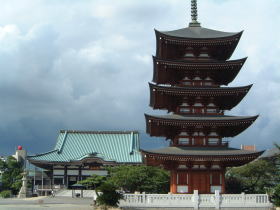 |
Kakuozan Nittaiji
覚王山 日泰寺
Kakuo (覚王)means Buddha, zan (山)means mountain,
Nit (日)means Japan,tai (泰)means Thailand, ji (寺)means temple
 |
Nittaiji was constructed in l904 as a repository for the true thumb bone
of Buddha Sakyamuni,
which was a gift from King Chulalongkorn, then a King of Siam (present
Thailand).
The story is as follows.
BRIEF HISTORY of NITTAIJI TEMPLE In 1898, while working on an excavation of an old mound at Piprahwa located in the border area of northern India near Nepal, an Englishman, William C. Peppe found a pot containing human bones. On the side of the pot was inscribed an ancient Indian script from the third century B.C. When deciphering of the script was successfully completed, it was confirmed that the human bones contained therein were those of Buddha Sakyamuni. It was claimed that the discovery was the greatest one ever made in Oriental history as it provided evidence that Buddha was a person who existed in history. As a result, the popular theory among Oriental schools which claimed the non-existence of Buddha was discredited. Realizing that the holy bones were so sacred for Buddhists that it was impossible for them to substitute the holy bones for anything else, the Indian Government took the step to donate them to Thailand, the only independent Buddhist country existing at that time in the world. King Chulalongkorn of Thailand, deeply moved by the donation, enshrined the holy bones in a temple in Bangkok. Later in 1900, in compliance with an enthusiastic request from the Japanese Government, the King issued an imperial edict agreeing to donate a portion of the Buddha's holy bones to Japan as a gift to Japanese Buddhists. To comply with the edict, the Japanese Buddhist community sent to Thailand a mission comprises of representatives of all Buddhist schools. The King handed the holy bones over to the mission in person at the Imperial Palace in Bangkok on June 15, 1900. In return, the mission informed the King of their plan to enshrine the holy bones in a temple to be built by supra Buddhist schools in Japan. So delighted with the news, the King gave the mission an additional donation of the principal Buddhist image to the new temple. It was a gift bronze statue in pure Thai style, more than one thousand years old. Furthermore, it was a national treasure and considered a very precious treasure in light of the fact that the casting technique of the statue had already disappeared in Thailand. Upon their return from Thailand, the mission of supra Buddhist schools held conferences to implement the plan to build the temple to enshrine the holy bones and the image. After considerable debates, they finally approved the scheme shown by enthusiastic Nagoya citizens to locate the temple in Nagoya. The temple was thus founded in 1904 at its present site in Nagoya and is named Nittaiji Temple. The holy bones are enshrined in a 15 meters tall stone stupa "Hoanto" in its compound. This stupa, designed by Chuta Ito, professor of Tokyo University, was completed in 1918. The granite stone structure is renowned as his masterpiece and is considered one of the most important works done by a Japanese. The present main temple which enshrines the Buddhist image as mentioned above was rebuilt in 1984. In commemoration of the completion of the main temple, King Bhumibol Adulyadej (a grandson of king Chulalongkorn) of Thailand kindly donated an additioal Buddhist image and a tablet inscribed in gold leaf in the Thai script written by the King himself. The tablet hangs inside the main temple and the letters carved on it read "Buddha Sakyamuni". Both sides of the writting are decorated with crests of King Bhumibol and King Chulalongkorn. The Nittaiji Temple, which literally means the Japan Thailand Temple, is an international temple as its name implies and a symbol of the friendly relations between the two countries. For the Japanese Buddhist community, the temple, being the only one which enshrine the holy bones of Buddha, the founder of Buddhism, is considered to be an especially important sacred place of worship. copy from a leaflet of Nittai-ji temple |
supplementary explanation:
When Mr. Inagaki Manjiro, the Japanese Minister to Thailand, got information
that the Thai King had presented
bones of Buddha to Buddhist countries: Burma ( present Myammar) and Ceylon
(present Sri Lanka),
he was eager to be shared them to Japan for Japanese Buddhists.
The bone was enshrined at Myoho-in temple in Kyoto temporarily.
It was very difficult to decide the place to enshrine the holly bone.
After the longtime discussion by the delegates of Japanese Buddhists,
at last in November 1902 they decided to build a new temple in Nagoya.
It was entirely due to the Nagoya citizens' perseverance that we could
get the result;
Many lords around Nittai-ji temple donated their lands for the new temple
(approximatery 82 acres).
At that time 13 Buddhist schools (56 groups) cooperated.
Because of the history of establishment, Nittai-ji became the only non-sectarian
Buddhist temple in Japan.
Now it is managed by 19 Buddhist schools in turn every 3 years.
The present country name "Thailand" was changed from Siam in
1932.
Therfore, the name of the temple "Nissen-ji (Japan Siam Temple)"
was changed
to "Nittai-ji (Japan Thailand Temple)" in 1941.
![]()
Sanmon
(main gate)
At the main gate (sanmon), there are two big statures which were placed
in 1989.
The left one is a image of Kasho-sonja (Mahaakassapa) who was the eldest
disciple of Buddha Sakyamuni and
became the leader of Buddhists after Buddha died.
The right one is a image of Anan-sonja (Aananda) who was a cousin of Buddha
Sakyamuni and served under him for 25 years.
The original sutras were compiled on his memory.
![]()
Hondo
(main temple)
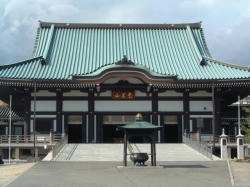 |
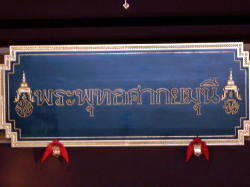 |
| main temple | tablet |
![]()
Goju-no-to
(Five-storied pagoda)
Please view the photo at the top of this page.
![]()
Hoanto
(Pagoda)
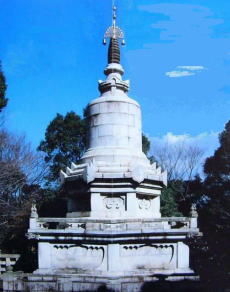 |
The gate to pagoda, where the holly Buddha's bone enshrined, will be opened
on some specific days, though we ususaly can see only the base of it.
Nobody can see the real holly bone now because it was embedded in the pagoda.
The 15m-high Gandhara style pagoda was designed
by the professor of Tokyo Univ. Ito Chuta and built in 1918.
| Hoanto is opened for special event | |
| Feb. 15 | Nehan-kai (the anniversary of Buddha Sakyamuni's death) |
| Apr. 8 | Hana-matsuri or Kotan-kai (Buddha Sakyamuni's birthday) |
| Jun. 15 | Hoan Kinen-hoyo |
| Nov. 15 | Hosen Kinen-hoyo |
| Dec. 8 | Jodo-kai (Buddha sakyamuni attained spiritual enlightenment) |
![]()
Temple Fair
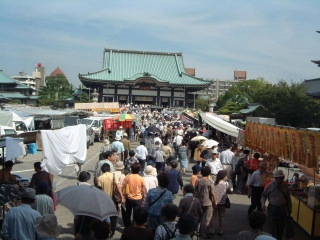 |
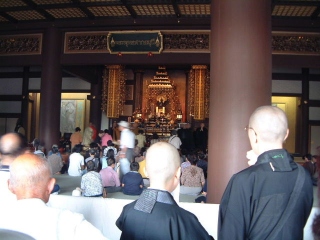 |
On the 21st of each month, a temple fair called "Kobo-san" is held along the approach to Nittai-ji
and is crowded with lots of religious senior people who enjoy shopping
and chattering.
There are more than 100 stalls on that day.
They sell lots of interesting things: foods, seramics, clothes for senior
people,
Buddhist alter fittings, garden plants,, etc.
The atmosphere is totally different from the modern shopping area like
Sakae,
and it makes you feel nostalgia for the old days.
The fair starts around 9:00a.m. and close around 2:00p.m.
Some small shrines like Sentai-Jizo-do will be opened on the same day.
Shikoku-Hachijuu-Hachikasho-Reijo is an interesting area.
![]()
October 23rd of each year, Memorial Day of King Chulalongkorn,
Thai people in Japan come and offer flowers to remind him.
Priests chant sutras everyday from 12:30p.m. at Hondo (the main temple)
You may come and join anytime you like.
You don't need donation.
![]()
access
Get off at Kakuozan sta. on the Higashiyama subway line.
Take exit 1. Turn to right and turn to right again at the next corner.
Walk 5 min.
map
Nittai-ji
1-1 Hoho-cho, Chikusa-ku, Nagoya
Tel: 052-751-2121
Fax: 052-752-1115
Monthly Info.
![]()